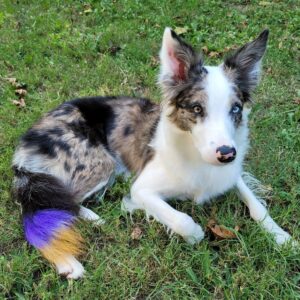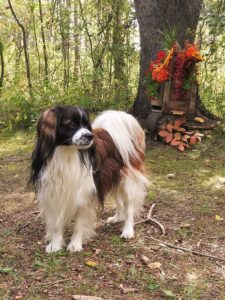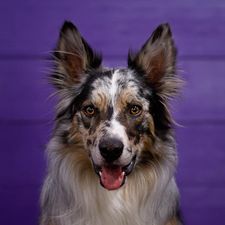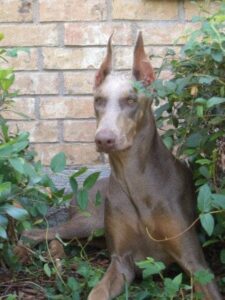Patterns
K Locus
The K locus affects whether or not the gene at the A locus (responsible for sable, fawn, tricolor, etc.) is visible. If a dog is K^BK^B, it will have a solid color coat (black, brown, gold), regardless of the genes at the A locus. If a dog is K^yK^y, then it will express the genes at the A locus.
This means that a dog who is K^BK^B cannot be visibly fawn, tricolor, etc. and cannot produce puppies that are fawn, tricolor, etc., regardless of the genetics of the other parent or their genes at the A locus.
Brindle
If a dog is K^BK^y, it may appear solid colored or brindle. The genetics behind the brindle phenotype is not completely understood at this point.
Seal
Seal is another coloration that can occur when a dog is K^BK^y. Seal is not fully understood, but it appears to add a reddish tone to the edges of the dog.
A Locus
The A locus is responsible for several black and tan “patterns.” Regardless of the genes at the A locus, unless the K locus is K^yK^y, the A locus pattern will not express on the dog. The K locus has a hierarchy of expression- A^y > a^w > a^t > a.
Sable (fawn, tan)
This is the color commonly found in Pugs, Great Danes, and Boxers. The sable color results from carrying one copy of the A^y gene. A sable dog is genetically K^yK^y A^y_E_. Sable ranges from heavily shaded (lots of black) to clear sable (tan with minimal black). A bb dog will have brown instead of black pigment. Sable is frequently seen with a melanistic mask (E^m_) in certain breeds. Clear sables are sometimes mistaken for reds (ee). If there is any black pigment (or brown) expressed on the dog (besides the nose), it is considered a sable. Reds (ee) cannot express black pigment on their body.
Agouti (wolf agouti, called sable in GSDs)
Agouti is a color pattern where the hairs have bands of different colors, instead of a solid color or color gradient. This gives the mottled appearance commonly seen in huskies and wolves. This color is called sable in GSDs, although it is not a true sable. As far as I know, agouti is not present in the border collie gene pool.
In order to express agouti, a dog must have the a^w_ gene. If it carries the A^y_ gene, ee, or is K^BK^B, it will not express agouti.
Gallery not found.Tan points (bicolor in GSDs, black/tan, red/rust, brindle point, tricolor, etc.)
Tan points occur when a dog is both K^yK^y and A^t_. The shade of the points depends on the base color of the dog. Sometimes the tan points have a brindle pattern. These dogs are called brindle points.
Recessive Black
Gallery not found.Saddle Tan (saddleback, saddleback sable, creeping tan)
Saddle tan is a pattern that restricts black (or brown) pigment to a “saddle” on the back. The saddle tan pattern is commonly associated with German Shepherds, Beagles, and Pembroke Welsh Corgis. Dogs with this pattern are usually born with a black/tan point appearance and the tan “creeps” along their body as they age, turning into a saddle pattern.
In order to show the saddle tan pattern, a dog cannot have ee or K^B_ and must be a^ta^t. Dogs with one or two copies of the N allele (N_, NN, NI) will appear saddleback. Dogs with two copies of the II allele will not have a saddleback pattern.
Gallery not found.





















































